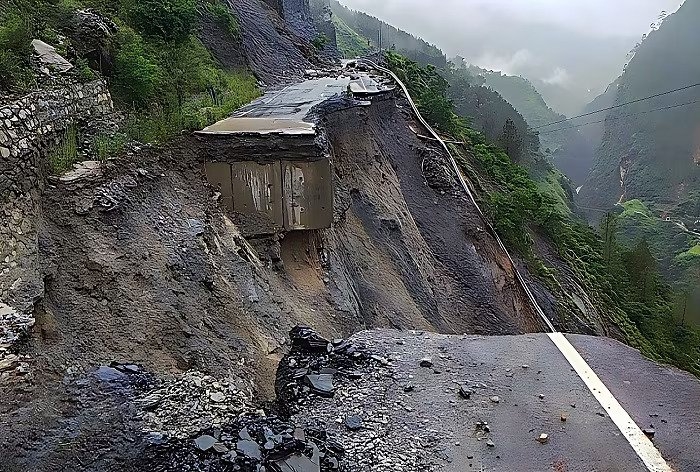Himachal Pradesh declared as 'Natural Calamity Affected Area': What is a 'national' calamity?
Total Views |
Shimla, Aug 19: As the state of Himachal Pradesh is battling the worst natural disaster in the last five decades, CM Sukhu has urged Prime Minister Narendra Modi to consider the declaration of the situation as a 'national calamity' of rare severity under the provisions of the Disaster Management Act of 2005.

Continuous rains wreaked massive havoc in HP, claiming the lives of over 74 people in the last few days, the government led by Chief Minister Sukhvinder Singh Sukhu on Friday (August 19) declared the whole state as a 'natural calamity'-affected area.
The statement came in the wake of destruction caused by incessant rain, triggering flash floods, cloudbursts, landslides, and slope failure taking a heavy toll on lives and property.
Himachal Pradesh declared as 'Natural Calamity Affected Area #HimachalPradesh pic.twitter.com/T8S1Ggc1au
— ANJALI ANKAD (@anjali_ankad) August 19, 2023
Thousands of tourists and local people who were stranded were evacuated with the help of the Indian Air Force (IAF), Indian Army, NDRF, and SDRF, Police, Home Guards, Fire Services and local volunteers.
Heavy rainfalls wreak havoc in Himachal
Based on the magnitude and intensity of losses to life (human beings, animals and livestock), property and infrastructure caused by the calamity, or when the situation caused by a calamity becomes unprecedented, beyond the coping capacity of the State Government and extremely difficult to handle through a normal rescue and relief operation, the Central government treats it as a calamity of severe nature which is known as 'national calamity'. This is majorly based on the recommendations of the Inter-Ministerial Central Team (IMCT), made in its report based on field observations subsequent to the said natural calamity.
Also, no specific criterion is given in the State Disaster Response Fund (SDRF) or National Disaster Response Fund (NDRF) guidelines for declaring a natural calamity as a calamity of severe nature.
CM Sukhu said that the state is waiting for a positive response from the Centre to declare the disaster in Himachal Pradesh as a national calamity soon. "Central teams have inspected the affected areas for loss assessment and we need timely help from the Centre," CM Sukhu said, adding that Himachal Pradesh has suffered an estimated loss of Rs 10,000 crore so far.
A total of over 2,000 houses have been fully damaged, and 9,615 houses have been partially damaged, with 113 landslides occurring in this year's monsoon season.
Since the onset of the monsoon in the hill state on June 24, 220 persons have died in rain-related incidents in Himachal Pradesh and 11,637 houses have been partially or completely damaged, according to the state emergency operation centre.
Over 600 roads are still closed in the state, out of which 550 would be opened in the next three-four days, said Public Works Department (PWD) Minister Vikramaditya Singh. About 408 transformers and 149 water supply schemes have been disrupted. Over the last three days, 2,074 people have been evacuated from the flooded areas of Kangra district.
The national highways, state, district and local road networks have been severely damaged and destroyed. Dozens of bridges have been washed away or damaged severely hampering connectivity and rescue efforts. The unprecedented excessive precipitation has led to a series of challenges that impacted daily life in the state.
District Administration supported by the Government has been carrying out relief and rescue activities, ever since the onset of monsoon, working day and night to save lives, provide relief to the affected persons, and restore essential services to minimize the impact of disaster.
What is a natural calamity?
Natural Disasters are catastrophic events that result from any of the earth’s natural phenomena. These can range from floods and hurricanes to tsunamis and earthquakes. The earth has seen several natural disasters and some of these disasters have led to mass extinctions and drastic repercussions for various surviving species.
There are four types of natural hazards- Geological Disasters, Hydrological Disasters, Meteorological Disasters, and Biological Disasters.
Principal Secretary (Revenue) Onkar Chand Sharma said that after the weather becomes normal and accessibility is improved, a complete assessment of the losses incurred by the hill state would be conducted and the report will be submitted to the Centre for recovery and reconstruction efforts.
Govt data on landslide-prone areas in Himachal:
As per reports, the government data clearly indicates that there are around 17,120 landslide-prone sites in Himachal Pradesh, adding that 675 of these are near critical infrastructure and habitations. The maximum of such prioritised landslide-prone sites are in Chamba (133) followed by Mandi (110), Kangra (102), Lahaul and Spiti (91), Una (63), Kullu (55), Shimla (50), Solan (44), Bilaspur (37), Sirmaur (21) and Kinnaur (15).


